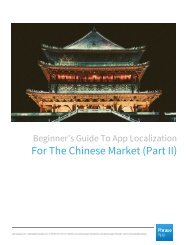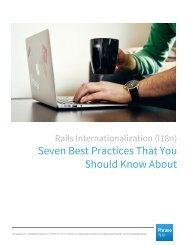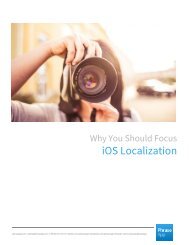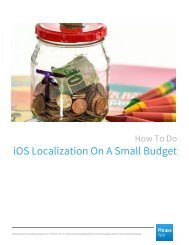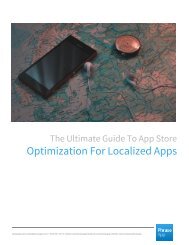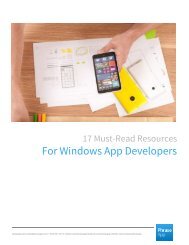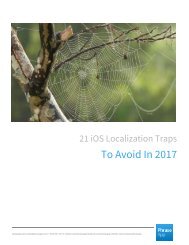Beginner’s Guide To App Localization For The Chinese Market (Part 1)
Create successful ePaper yourself
Turn your PDF publications into a flip-book with our unique Google optimized e-Paper software.
<strong>Beginner’s</strong> <strong>Guide</strong> <strong>To</strong> <strong>App</strong> <strong>Localization</strong> <strong>For</strong> <strong>The</strong> <strong>Chinese</strong> <strong>Market</strong>tion (<strong>Part</strong> I)<br />
4. Pay Attention <strong>To</strong> Translation: <strong>Chinese</strong> Is Tricky<br />
One of the most important steps in the app localization process is translation. As many <strong>Chinese</strong><br />
translators don’t have in-depth knowledge of Western ways of talking, you should look for a<br />
diverse team. Try to include locals and native speakers living outside of China.<br />
This way, you’ll make sure your message is translated correctly, respecting local syntax and<br />
terminology, and staying in keeping with your global brand. Give your translators details about<br />
your app, as they need context to come up with an accurate translation.<br />
When localizing for China, it’s impossible to deliver a high-quality product using automated<br />
translation. So, don’t try to save money by using Google Translate or any other similar<br />
software. <strong>Chinese</strong> people like complex expressions and have different expectations when it<br />
comes to writing styles. You need human translation to make sure your messages are<br />
appropriate for the target audience.<br />
Translate all content, from titles, descriptions, texts inside images, error messages and<br />
feedback requests. Don’t leave anything out, or your app will be instantly deleted. If you’re not<br />
sure which <strong>Chinese</strong> language to choose for your translation, you should know that Mandarin<br />
and Cantonese are spoken languages and have nothing to do with your written content.<br />
<strong>The</strong> only case where you’d need to decide on using one or the other is if you include voice<br />
messages in your app. In this case, you should probably opt for Mandarin, as it’s the official<br />
language in both China and Taiwan.<br />
<strong>Chinese</strong> has two writing systems, though. Simplified <strong>Chinese</strong> is used in China and Singapore,<br />
while Traditional <strong>Chinese</strong> is used in Hong Kong and Taiwan. Depending on your target market,<br />
you’ll need to choose one system over another.<br />
phraseapp.com | sales@phraseapp.com | +49-40-357-187-76 | twitter.com/phraseapp | facebook.com/phraseapp | linkedin.com/company/phraseapp




